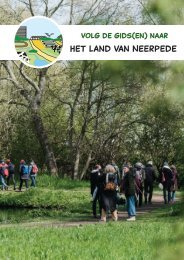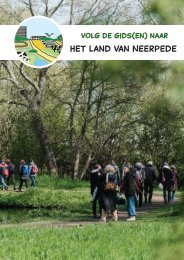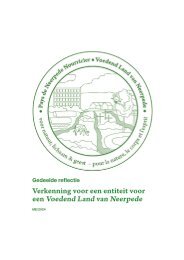Cities4PEDs Atlas_November 2021.pdf
Atlas - From 7 case interviews to recurring strategies and PED relevant aspects
Atlas - From 7 case interviews to recurring strategies and PED relevant aspects
- No tags were found...
You also want an ePaper? Increase the reach of your titles
YUMPU automatically turns print PDFs into web optimized ePapers that Google loves.
Bospolder-Tussendijken in Rotterdam, the Netherlands is an example of a<br />
uniform, locally<br />
supported district with<br />
energy as a lever<br />
A<br />
B<br />
C<br />
Bospolder Tussendijken is a pre-war neighbourhood with some modernist interventions, a<br />
diverse urban typology. In these districts, we recognise a limited number of spatial typologies<br />
that are repeated several times: for example, small row houses with private gardens or<br />
apartments with a collective courtyard, public buildings such as schools or libraries that are<br />
repeated identically, small parks and squares between the dwellings, etc. These repetitive<br />
building blocks are mostly owned by housing corporations. The districts are often located<br />
on the outskirts of the city and are rather outdated, attracting mainly socio-economically<br />
vulnerable residents, resulting in a higher poverty index than average. The streets are caroriented.<br />
Small-scale public transport is fairly well provided for, but the real mobility hubs are<br />
located outside the district.<br />
The location on the edge of the city is usually an opportunity to connect to industrial<br />
activities and their residual heat. As the energy transition is often not the main urgency in<br />
these neighbourhoods, solutions are sought that can simultaneously leverage other societal<br />
challenges, such as improving the quality of living or resolving daily life problems like<br />
draughts, mould and moisture. The uniform character of the district and the rather centralised<br />
form of ownership (via corporations, for example) allows for the implementation of and<br />
connection to centralised infrastructure, such as district heating. The location on the edge<br />
of the state is usually an opportunity to connect to industrial activities and their residual<br />
heat, such as the port in the case of Rotterdam. The energy system to be implemented<br />
is a combination of centralised (residual heat net) and decentralised energy strategies,<br />
with a focus on low-cost, low-tech solutions that are affordable and can be implemented<br />
incrementally (like for example local sustainability coaches, cultural projects, isolation<br />
programmes and collective solar projects).<br />
There are often many self-organised residents’ groups and communities in these<br />
neighbourhoods, which deal with issues such as affordable housing, food distribution, public<br />
space, etc. At the same time, there is a clear national agenda concerning the energy transition<br />
(for example the decision to be gas free by 2030 in the Netherlands). An in-between table that<br />
connects existing local networks with different city departments and national governments<br />
aligns the local with the supra-local interests and facilitates a structural conversation<br />
between them. In the case of BoTu, this matchmaking role was played by a team of the<br />
city administration, a neighbourhood cooperative, a cultural organisation (the Architecture<br />
Biennial), a design agency, technical experts and anthropologists. They set a mutual agenda<br />
that culminated into a Local Energy Action Plan (LEAP). The uniform character of the district<br />
allows to develop a series of case studies that are representative for the district as a whole (a<br />
school, an archetypical apartment building, a street of row houses, etc.).<br />
Working document<br />
This strategy is closest to the other existing districts, in the sense that the support for the<br />
projects comes from the local residents (cf. a.o. Brussels). Energetically, it is similar to Lyon<br />
in terms of the combination of centralised and decentralised energy infrastructure.<br />
Other examples that could (partly) fit this category are: Climate Neighbourhood Mechelen, Sinfonia Innsbruck<br />
47


















